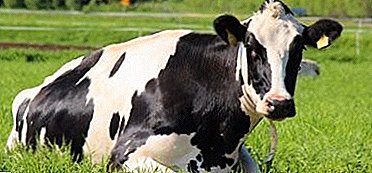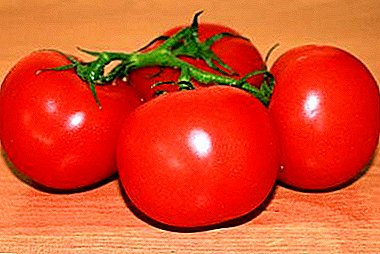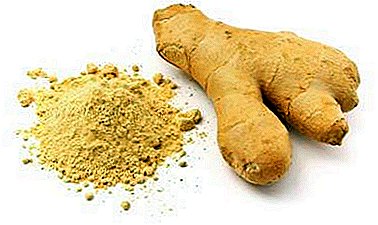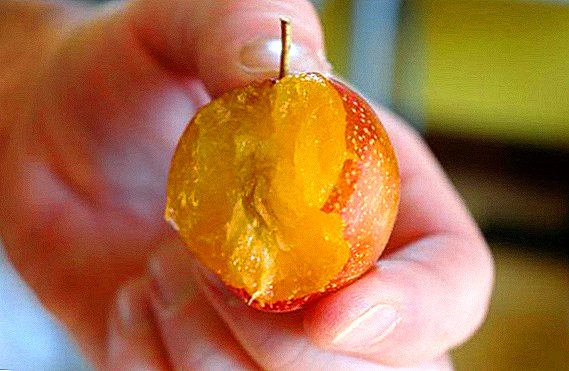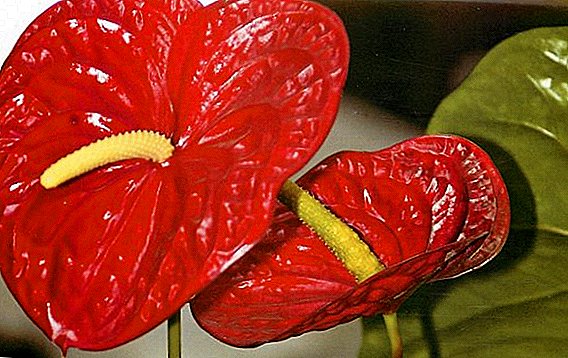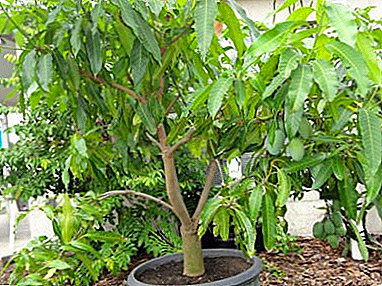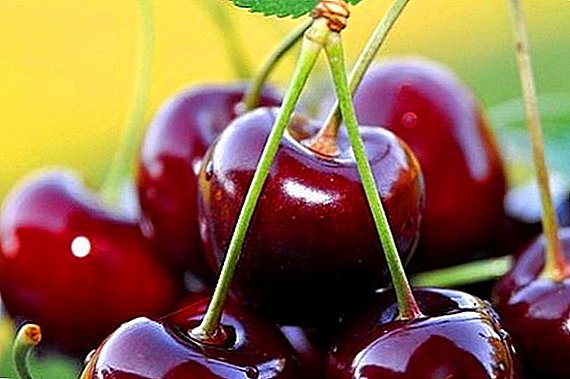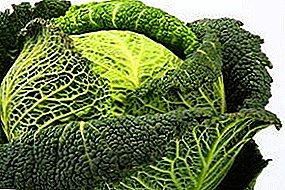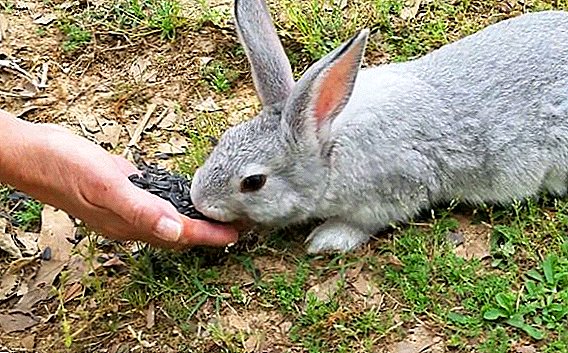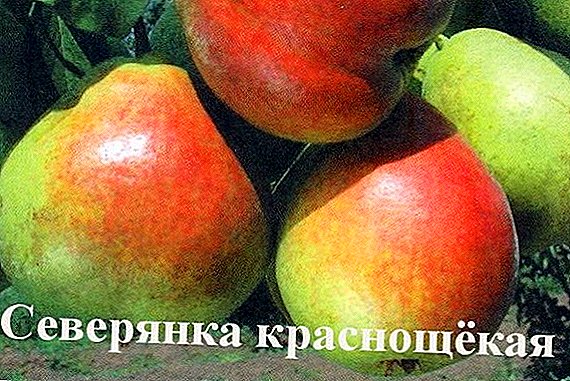 For the northern regions, it is often difficult to find varieties of fruit trees. Research institutes are constantly working on the removal of frost-resistant varieties.
For the northern regions, it is often difficult to find varieties of fruit trees. Research institutes are constantly working on the removal of frost-resistant varieties.
One of the fruits of such works is the variety Severyanka red-cheeked pears, consider its description, pros and cons.
Breeding history and breeding region
Much attention in the Soviet selection was paid to the cultivation of varieties of fruit trees for the northern regions. So, in scientific research institute it. Michurin breeder P.N. Yakovlev crossed "Klapp's Favorite" and "Kopirechku" and produced a frost-resistant pear, which was first named "Seedling Yakovlev", and later - "Severyanka Yakovlev". Later the name was reduced to "Severyanka".  In the course of further research, she was crossed with Krasnoshchekoy. And at this time, "Severyanka red-cheeked" successfully displaces other varieties from the northern regions. In 1998, admitted to state variety testing.
In the course of further research, she was crossed with Krasnoshchekoy. And at this time, "Severyanka red-cheeked" successfully displaces other varieties from the northern regions. In 1998, admitted to state variety testing.
Did you know? One pear contains 20% of the daily value of fiber, as well as 10% of the norm of vitamin C and 6% of potassium.
Tree description
The maximum height of a tree, which is reached in the 14th year of life, is about 5-6 metersgrows more intense in width. The trunk and branches are quite powerful, the bark has a gray tint. Crohn middle density and pyramidal shape. The leaves are medium in size, with a glossy surface of dark green color, at the edges have cloves.
Fruit Description
Small fruits, weighing approximately 100 g. The peel is smooth, yellowish-green, and when fully matured it is bright yellow. About half of the surface is covered with a rich scarlet blush. The pulp has a tint of ivory, medium in density, very juicy. The taste is sweet and sour, there is no astringency. Near the core there are stony impregnations that negatively affect the taste. Pears of this variety contain about 9% sugars. 
Lighting Requirements
The best option for planting seedlings will be a sunny, bright place, because the pear is quite demanding of lighting. You should also set aside a large area for planting a seedling, preferably without drafts.
Soil requirements
There are no special requirements for soils, but it is better to choose well-drained areas and fertile soils. Before planting in the pit should be three buckets of humus, 200 g of superphosphate. Subsequently, the soil and trees are fertilized every year with organic matter, phosphate and potash supplements. The tree does not tolerate stagnant moisture and excessive watering.
Read the description and peculiarities of growing varieties of pears: "Kyrgyz Winter", "Verna", "Noyabrskaya", "Zaveya", "Williams Red", "Williams Summer", "Beautiful Chernenko", "Allegro", "Abbot Vettel", Bere Bosk, Starkrimson, Just Maria.
Pollination
The tree blooms early - as early as April-May flowers appear. Self-fertility of this pear is low, the ovary is formed only on 30% of flowers, so it needs pollinators to get a good harvest. The “Memory of Yakovlev” variety is best suited for this. These two varieties are recommended to be planted close to each other.
Fruiting
The fruiting of the tree on average begins in the fourth year after planting, so the variety is considered skoroplodnym, refers to the mixed type of fruiting. 
Gestation period
The variety is rather early: the fruits ripen already in the middle of August, since when it was bred it was designed for cultivation in regions with a short summer period. Crop quickly showered after ripening.
Important! To extend the shelf life of pears to two months, harvest should be about a couple of weeks before full maturity.
Yield
"Northerner red-cheeked" is considered quite a fruitful variety. The first crop is harvested from 3-4-year-old seedlings, and already from a six-year tree it is possible to collect up to 20 kg of fruits. An adult tree produces 45 to 60 kg of crop. In the most favorable conditions, you can collect a centner of fruit.
Transportability and storage
But the shelf life of these pears is small - about two weeks, then the pulp turns brown. Store in a cool place, preferably in wooden boxes. But the short shelf life is offset by good portability of transportation. 
Resistance to environmental conditions and diseases
This variety is almost not susceptible to diseases and pests. May occur such ailments:
- bacterial burn - due to freezing of the leaves. The affected tree must be treated with antibiotics for 5 days;
- fruit rot - brown spots appear on the pears, which increase over time and destroy the crop. To combat this disease, wood is sprayed with Bordeaux mixture or copper chloride;
- Mycoplasma disease is the most dangerous disease of fruit trees. Carriers are pests. A tree that has undergone such a disease cannot be cured, it must be uprooted.
 Of the pests, only the hawthorn butterfly is in danger. When the butterfly caterpillars are found, the pear is treated with Iskra or Karbofos.
Of the pests, only the hawthorn butterfly is in danger. When the butterfly caterpillars are found, the pear is treated with Iskra or Karbofos.Important! All woodworking work must be carried out in personal protective equipment (gloves, respirators).
Winter hardiness
Frost resistance - One of the main distinguishing characteristics of this variety. There have been cases when only young saplings died during a short-term decrease in temperature to -50 ° C. And at stable frosts with a temperature of about -42 ° C, only the ground part of the trees dies. Also "Severyanka red-cheeked" has the ability to recover quickly after frost.
Fruit use
Due to the average taste characteristics, as well as small storage period, "Severyanka red-cheeked" is used mainly for harvesting. It makes delicious candied fruits, jams and compotes. Also pears can be dried. 
Advantages and disadvantages
To summarize the above, highlighting the advantages and disadvantages of this type of pear.
pros
The positive qualities include:
- frost resistance;
- resistance to many diseases, especially scab, and pests;
- early maturity;
- unpretentiousness;
- high yield.

Did you know? In ancient Greece, pears were used as a means of motion sickness. At sea crossings, the Greeks absorbed pieces of pears in their mouths and thus escaped from seasickness.
Minuses
This pear has negative sides:
- short shelf life of fruits;
- mediocre taste;
- small size of pears;
- the crop quickly showered after ripening.
To date, pear "Severyanka red-cheeked" is almost not used on an industrial scale, since in recent years many other winter-resistant varieties with a longer shelf life have been bred. Trees can be found only in amateur gardeners. But this variety is actively used for breeding purposes.


